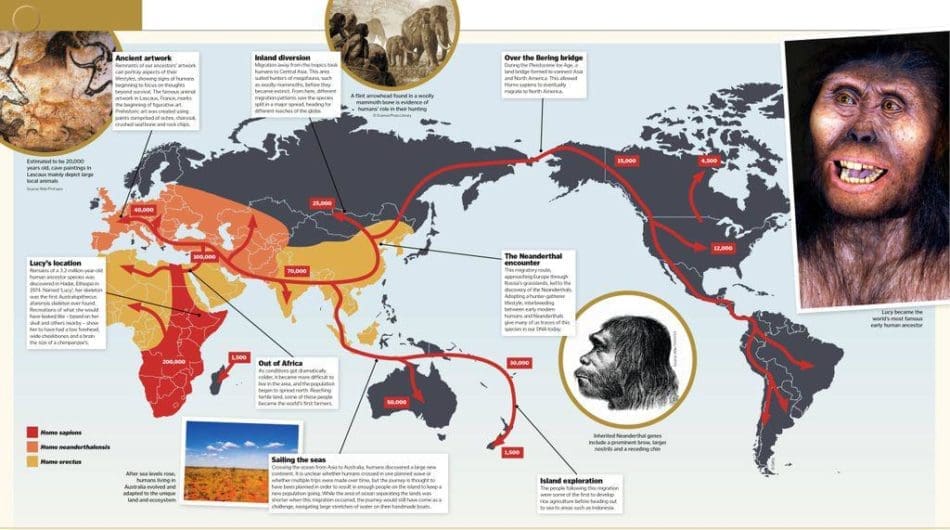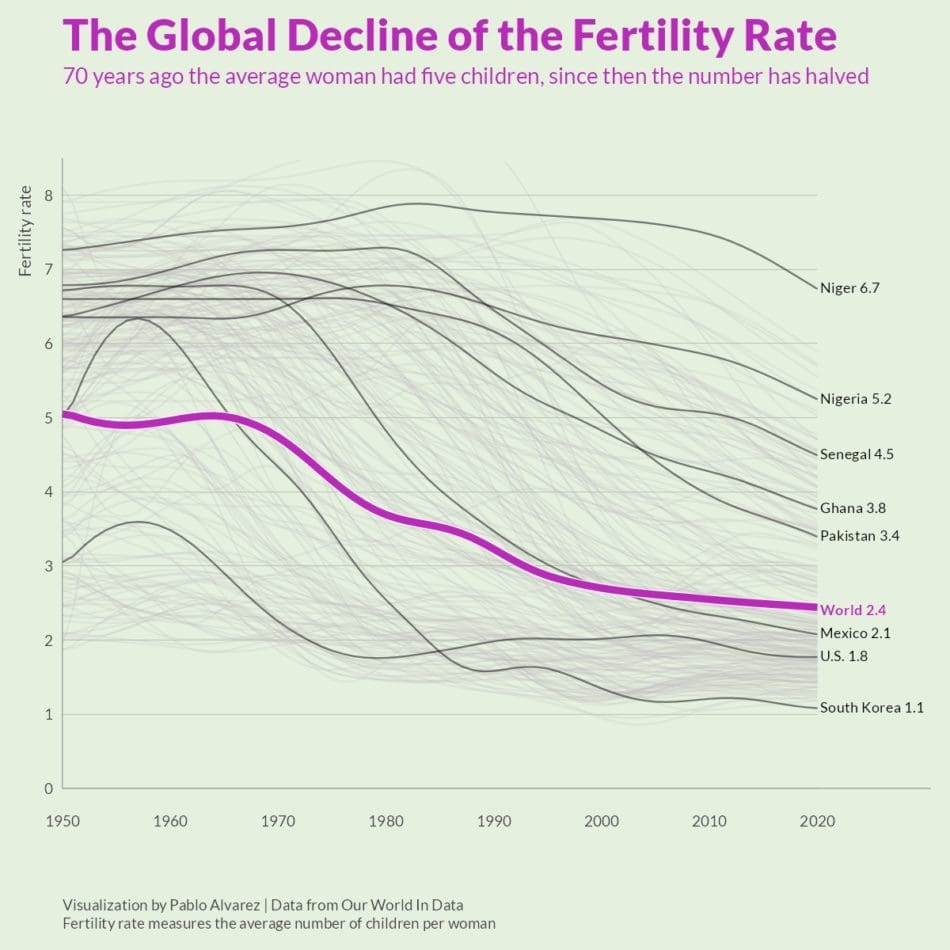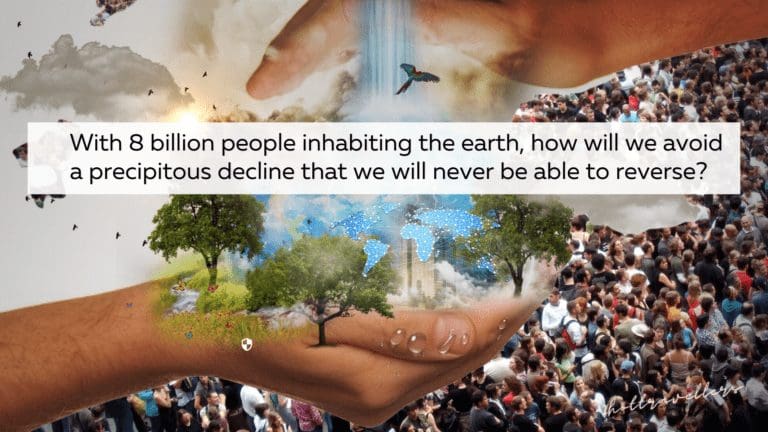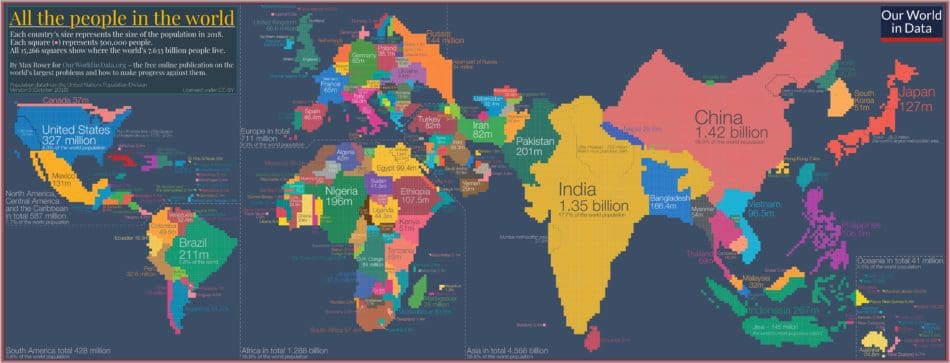It is impossible to know with absolute certainty how many people are currently on the planet at any given moment; however, according to the most recent projections made by the United Nations, the number of living humans is expected to reach 8 billion on November 15, 2022.
To the tune of $8,000,000,000 PEOPLE
It’s impossible to fathom, but try to picture it this way: It took about 20 people to join the world’s population while you were reading this paragraph.
The population of the Earth is rising rapidly, but the rate of increase is slowing recently. The sky is falling, and with it, our civilizations.
Every day, humanity evolves in ways we can’t see in the short term, but which will radically alter our world in the next century.
We’ve reached “peak child,” when there are no longer going to be as many babies born as there are now because of falling fertility rates.
The population as a whole is aging, and as a result, fewer people are able to provide for the rising number of people who are no longer able to work.
As cities grow, they consume more and more farmland, reducing the amount of land available for agriculture.
There has been a significant shift occurring in the world’s most populous megacities recently.
According to Elin Charles-Edwards, a researcher at the University of Queensland, “This is a fundamental transformation of what it looks like for a society to look like.”
“We’ve gone through a pretty extraordinary period in the 20th century and into the 21st century,” the author writes, “where we’ve gone from demographic regimes in which there are lots of children and people were dying younger to a period of really rapid growth.”
Now is the time for us to grapple with the repercussions, as well as the opportunities.
But before we can get to the bottom of what it all means, we need to go back to the beginning.
We have made significant progress very quickly.
About 300,000 years ago, Homo sapiens first appeared on the face of the earth. They, like other early humans that were living at this time, gathered and hunted food, and they developed behaviors that helped them respond to the challenges of surviving in unstable environments.
The population of our species expanded at a slower rate in the beginning, despite the fact that we had evolved to have large brains and long legs.

Around the time of Cleopatra’s death, when the ancient Egyptian civilization was coming to an end, there were probably about 230 million of us living on this planet.
By the time the Renaissance occurred in 1500, the population had already more than doubled, and it did so once more by the year 1805 when the ancient Egyptian civilization was being rediscovered with the assistance of the Rosetta Stone.
These are all pretty rough estimates; we didn’t have complete censuses in the Middle Ages, but the human population has been on a slow burn, until recent centuries, when it has boomed. This is because we didn’t have comprehensive censuses back then.
In 1925, just prior to the onset of the Great Depression, the two billion mark was passed, and from that point onward, it took only another 35 years to reach the three billion mark.
Since then, the world’s population has been expanding at a rate of one billion new people every ten to fifteen years.
Where are we planning on going exactly?
Within the next few decades, there will probably be a couple of billion more mouths to feed all over the world.
According to the United Nations’ most recent projections, which were made public earlier this year, there will be approximately 9.7 billion people living on this planet in the year 2050.
According to John Willmoth, who is the director of the population division at the United Nations, “demographic projections are highly accurate,” and this has to do with the fact that the majority of the people who will still be alive in 30 years have already been born.
However, when you start looking seventy or eighty years into the future, there is a great deal more uncertainty.
The United Nations estimates that by the 2080s, the global population will have reached approximately 10.4 billion, based on its most likely projection.
After that, it is projected to remain stable for the next couple of decades before beginning a decline at the beginning of the 22nd century.
On the other hand, the range of plausible outcomes in the year 2100 is significantly larger, falling anywhere between 8.9 and 12.4 billion. There is yet another international model of population growth that was recently published by a group that specializes in the research and analysis of health data called the IHME. This model projects an earlier population peak and a more rapid decline.
According to Amanda Smith, senior research manager, “the major reason that we forecast a different global population in the last third of the century comes from how we are modeling fertility.” This is the primary cause for the difference in population projections.
“Our model suggests that we expect fertility to continue to decline through the end of the century in many countries,” the author writes. “This is contributing to a larger and faster global population decline than the projections of the United Nations.”
The “replacement number” that makes the world’s population grow is 2.1, which means that if women have an average of one more child than that, then the world’s population will grow. The population will decrease if the fertility rate continues to fall.
And in that direction, we are going to go.
Dr. Charles-Edwards believes that we have now reached our maximum number of children. “There will never be a time in the history of the world when there are more children alive than there are right now.”
The 1950s were the most fertile decade, with women having five children on average during that time period.
That number varied greatly depending on which part of the world you looked at it.
But ever since then, fertility rates have consistently been on the decline. In point of fact, fertility rates have already fallen below the number needed to replace them in certain regions of the world. These regions include parts of Australia, Europe, North America, and some parts of Asia. It is only because of our immigration program that Australia’s population is growing at this point.
Due to the fact that different regions have varying rates of fertility, population decreases will be seen in some regions before they are seen in others.
This process has already begun in some countries.

Developing nations that are shrinking
The United Nations estimates that the populations of the Baltic states and the countries bordering them have shrunk by at least 1% since 2015.
Much more people left Ukraine as a result of the ongoing war, contributing to the country’s dramatic population decline.
Numerous countries are forecast to have smaller populations by 2050 than they do today.
These are the nations where birthrates are low, and immigration isn’t meeting demand.
Due to the worldwide decline in fertility rates, more and more countries will be filled in over the next few decades.
Ultimately, the entire planet will age.
Old age is something that we can’t avoid.
As a species, we tend to think more about our beginnings than our endings. Our culture has a hard time broaching the subjects of aging and mortality.
But we can’t deny that the shifting demographics of the world will have far-reaching effects on our way of life.
“If you want to think about the future demographic challenges, I think population aging is probably number one in terms of people needing to change the way they do things, their expectations, and governments needing to change public systems that support the older population,” says Mr.
Consequences like a rise in the need for medical and retirement care are easy to see.
Welfare expenditures in nations with government-funded pension plans for the elderly will rise, and there will still be a labor shortage.
There are fewer people in each family, so many developed nations are planning to downsize their housing stock to accommodate their aging populations.
However, our transportation networks, which excel at ferrying workers between significant business districts, are woefully inadequate at delivering us to and from the suburbs’ grocery stores, parks, and medical facilities.
What will happen if we all stop working and more people start relying on others for transportation and daily needs?
It will alter not only the composition of our societies but also the feel of our cities and the ways in which we navigate them.
Dr. Charles Edwards stresses the importance of considering the aging population when planning urban areas. “We do need to be designing cities, for example in Australia, with a view that there are going to be many older Australians here,” he says.
Workplaces in general will be affected. Since there will be fewer people to do the work and more people will need to be cared for as a result of the population’s aging, businesses may need to turn to automation, artificial intelligence, and robotics to fill the void.
Expert in artificial intelligence and startup founder Vaibhav Namburi predicts a radical transformation of the office environment due to the widespread adoption of robotic processes.
He predicts that in the next ten, twenty, or thirty years, many “mundane” or repetitive jobs will be eliminated and that their workers will be retrained to focus on higher-level skills.
Perhaps we’ll all be putting in more efficient hours, but will we also be working harder? After all, working from home has forced many of us to put in extra hours during the pandemic.
Mr. Namburi argues that this goes against the spirit of the remote, flexible work lifestyle.
I hope that the next century sees a greater emphasis placed on the importance of maintaining a healthy work-life balance for one’s mental well-being.
Countries with rapid economic growth
Various regions of the world are dealing with unique challenges.
In the earlier map, you may have noticed that there were no African countries experiencing a population decline.
Africa is currently among the world’s fastest-growing regions.
By 2050, it is predicted that eight countries will account for more than half of the global population growth.
Next year, India will surpass China as the world’s most populous nation.
There are ten countries in total: five in Africa (Nigeria, Tanzania, Ethiopia, the Democratic Republic of the Congo, and Egypt) and five in South Asia (Pakistan and the Philippines).
More than half of the world’s population growth between now and 2050 will come from just eight countries.
The economies of many countries in Sub-Saharan Africa are expanding rapidly.
Although there is a lot of uncertainty with projections that far out, it is expected to have roughly a third of the world’s population by the end of the century.
Predictions for 2100 show that Africa will be home to 38% of the global population.
That’s a lot of extra people living in a place with some of the world’s worst poverty.
There is a lot of focus on development efforts that aim to ensure food production keeps up with the pressures of a growing population and the effects of climate change.
Daniel Wordsworth, CEO of World Vision, says it’s a major problem in countries like Somalia, which is experiencing the worst drought in decades.
A tangled web of fishing lines is how he describes it.
There is no underlying cause, but rather many factors that are mutually reinforcing and tangled up with one another, making progress painfully slow.
Climate change is a real problem in Somalia, where the country has been experiencing a severe drought for the past five years.
As an additional factor, “you have a country that has gone through, like all of us, two years of economic lockdown and shutdowns… and war has broken out in this country.”
In fact, according to Dr. Rachel Carey, an expert in sustainable food systems at the University of Melbourne, producing enough food isn’t the primary issue.
As of right now, she says, “the world has produced enough food,” meaning that food production has kept up with demand.
There has been enough food produced globally, but there are occasional reports of food shortages in specific areas; this may be due to climate change or war.
The main problem has been the current system of unequally distributed food.
The rapid urbanization that began in the nineteenth century and accelerated in the twentieth century is also shaping the world.
Since 2017, urban populations have outnumbered rural ones.
From its current 55%, the urban population share will continue to rise. According to Dr. Carey, this could have an effect on the availability of prime farmland in the future, which in turn could increase the strain on the food supply.
She explains that cities are typically established in agrarian regions, near rivers and other sources of food.
“As cities expand, they often expand into highly fertile areas of farmland, both horizontally and vertically.”
The University of Sydney, for example, has researchers developing robotic farming technology that could be useful.
Dr. Rachel Carey argues that while much is being accomplished, it is not yet enough.
She argues that “we need to do much more” and “I think we need to do it much faster.”
Will we be able to handle these difficulties?
Now, the question is, what kind of existence do you envision for the planet’s estimated 9 billion inhabitants?
Will a smaller economy be the result of fewer babies being born? The question is how we’ll overcome the difficulty of ensuring a secure retirement for everyone. Should we reevaluate city planning in light of the growing number of retirees who no longer need to commute to work? Will the promise of more free time and less labor be fulfilled by the fourth industrial revolution’s robots and AI?
This may sound like the beginning of a dystopian science fiction novel, but experts assure us it’s not.
Demographers are generally upbeat people, according to Dr. Charles-Edwards, because they have witnessed so much progress over the past century.
“As a result, people of all ages are living longer than ever before.
“We have improved upon previous performance across the board. The cumulative effect of many seemingly insignificant initiatives has had a profound impact on people’s lives.”
But, as with most international issues, the effects won’t be distributed fairly, and richer nations must also deal with the related difficulty of deciding how much they are willing to give up in order to aid poorer nations.
Dr. Elin Charles-Edwards warns that the most at-risk populations will feel the effects of climate change the most acutely.
“Being wealthy allows for greater flexibility than would otherwise be possible.
“The issue of climate change has been largely ignored. As a result, we must keep in mind that some of the areas that will be hit the hardest are also the weakest in terms of their ability to recover quickly.”
This is now a challenge. The next step is up to the human race.
















